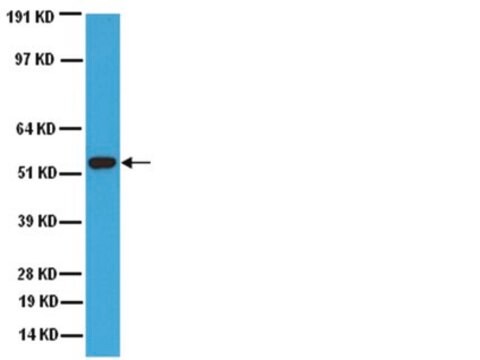MABT340
Anti-Proteinase 3/PR3 Antibody, clone MCPR3-2
clone MCPR3-2, from mouse
Sinônimo(s):
Myeloblastin, AGP7, C-ANCA antigen, Leukocyte proteinase 3, Neutrophil proteinase 4, NP-4, P29, PR-3, PR3, Wegener autoantigen
About This Item
Produtos recomendados
fonte biológica
mouse
Nível de qualidade
forma do anticorpo
purified antibody
tipo de produto de anticorpo
primary antibodies
clone
MCPR3-2, monoclonal
reatividade de espécies
human
não deve reagir com
mouse
técnica(s)
ELISA: suitable
affinity binding assay: suitable
flow cytometry: suitable
western blot: suitable
Isotipo
IgG1κ
nº de adesão NCBI
nº de adesão UniProt
Condições de expedição
wet ice
modificação pós-traducional do alvo
unmodified
Informações sobre genes
human ... PRTN3(5657)
Descrição geral
Especificidade
Imunogênio
Aplicação
Cell Structure
Inflammation & Autoimmune Mechanisms
Flow Cytometry Analysis: A representative lot detected a large population of human peripheral blood neutrophils with surface PR3. The entire population became positively stained after TNFa-stimulation (Hinkofer, L.C., et al. (2013). J. Biol. Chem. 288(37):26635-26648).
Flow Cytometry Analysis: A representative lot bound immobilized recombinant human PR3 via a distinct epitope than those recognized by clone MCPR3-3 and MCPR3-7 (Cat. No. MABF973 and MABT403, respectively) as determined by FACS analysis of bead-based competition binding assay (Silva, F., et al. (2010). J. Autoimmun. 35(4) 299-308).
Flow Cytometry Analysis: A representative lot bound recombinant human PR3-, but not murine PR3-, coated Talon-beads as determined by FACS analysis. (Silva, F., et al. (2010). J. Autoimmun. 35(4) 299-308).
ELISA Analysis: Representative lots were immobilized on well surface and employed to capture purified human polymorphonuclear cell PR3 or recombinant human PR3 S176A mutant, followed by affinity pull-down of PR3 autoantibodies (anti-neutrophil cytoplasmic antibodies or ANCA) from patients serum samples by the captured PR3 and the subsequent detection of the bound ANCA by alkaline phosphatase-conjugated goat anti-human IgG (Silva, F., et al. (2010). J. Autoimmun. 35(4) 299-308; Sun, J., et al. (1998). J. Immunol. Methods. 211(1-2):111-123).
Western Blotting Analysis: A representative lot detected an exogenously expressed S176A mutant PR3 in lysates from transfected HMC-1 human mast cells as well as purified PR3 from human polymorphonuclear cells (Sun, J., et al. (1998). J. Immunol. Methods. 211(1-2):111-123).
Affinity Binding Assay: A representative lot captured a recombinant human PR3 construct proP-PR3ctp that adopts a pro-PR3 conformation and a recombinant construct ΔPR3ctp-S195A that adopts a mature PR3 conformation with similar affinity (Hinkofer, L.C., et al. (2013). J. Biol. Chem. 288(37):26635-26648).
Qualidade
Isotyping Analysis: The identity of this monoclonal antibody is confirmed by isotyping test to be IgG1κ.
Descrição-alvo
forma física
Armazenamento e estabilidade
Outras notas
Exoneração de responsabilidade
Não está encontrando o produto certo?
Experimente o nosso Ferramenta de seleção de produtos.
Código de classe de armazenamento
12 - Non Combustible Liquids
Classe de risco de água (WGK)
WGK 1
Ponto de fulgor (°F)
Not applicable
Ponto de fulgor (°C)
Not applicable
Certificados de análise (COA)
Busque Certificados de análise (COA) digitando o Número do Lote do produto. Os números de lote e remessa podem ser encontrados no rótulo de um produto após a palavra “Lot” ou “Batch”.
Já possui este produto?
Encontre a documentação dos produtos que você adquiriu recentemente na biblioteca de documentos.
Nossa equipe de cientistas tem experiência em todas as áreas de pesquisa, incluindo Life Sciences, ciência de materiais, síntese química, cromatografia, química analítica e muitas outras.
Entre em contato com a assistência técnica